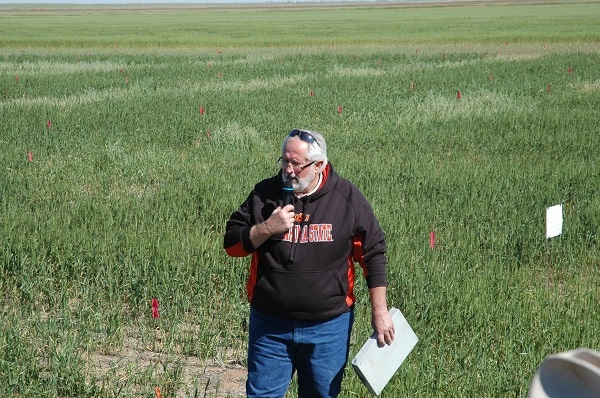
Wild oats, rescuegrass, jointed goatgrass and a few other pernicious weed pests pose challenges to Oklahoma wheat producers. But growers have management options, says an Oklahoma State University Extension county educator.
Gary Strickland, Jackson County, says several herbicides provide good to excellent control for some of Oklahoma wheat farmers’ worst weed problems.
Wild oats can be a tough one, Strickland said during a recent field day and dedication ceremony for the recently completed Tipton Valley Research and Education Center, near Tipton. “We have good products,” he said during the field tour.
Topping his list is Axial XL, a Syngenta product, which does an “outstanding job applied at the two- to three-tiller stage of wild oat growth.”
The herbicide also offers a broad spectrum of control, including broadleaf weeds in both moist and drought conditions.
PowerFlex, from Dow, also “does a good job with wild oats,” Strickland said, “but control falls off a little under drought stress. We see a little less uptake by the plant. But with a little moisture, it does an outstanding job and offers a good spectrum of broadleaf control, including marestail, and it will suppress rescuegrass.”
For the latest on southwest agriculture, please check out Southwest Farm Press Daily and receive the latest news right to your inbox.
Osprey, Bayer CropScience, also does a good job and offers a little ryegrass control but “is not strong on broadleaf weeds, and control will fall off during a drought.”
DuPont’s Finesse, he said, does offer good control during drought, “but it’s expensive.”
He said a new weed management approach combining preplant and pre-emergence treatments should improve results. “We want to deal with weeds as they start to come up,” Strickland said. “If we wait longer, weeds compete for moisture and nutrients.”
He said PrePare herbicide from Arysta LifeScience also offers good rescuegrass control and may be applied “with a light shot of Roundup, preplant or pre-emergence. “It seems to be a promising option,” he said. He recommends applying at the one-to three-leaf stage. “You have to get it then or it will escape and make a seedhead.”
Weakness in system
The weakness with this and other herbicides, he said, has been a four to four-and-half year drought. “We have not had good moisture support. We see a lot of promise but we want to see products when we have more moisture to determine if we get replication.”
Mark Gregory, Extension agronomist, said Clearfield wheat options also offer potential for improved weed control, especially for rescuegrass, jointed goatgrass and feral rye. “PowerFlex can help if we are timely, but we often miss it.”
With Clearfield varieties, producers can use Beyond herbicide, from BASF, “to take out rescue grass, jointed goatgrass and feral rye.”
He said Doublestop Cl Plus, with two resistant genes, allows growers to use Beyond herbicide, which is “hotter. Doublestop is a good variety and performs well on low pH soils.”
About the Author(s)
You May Also Like






